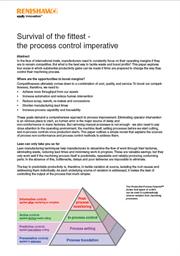현재 사용 중인 언어로는 이 페이지를 사용할 수 없습니다. Google Translate을 사용하여
자동 번역된 페이지
를 볼 수 있습니다. Renishaw에게는 이 서비스를 제공할 책임이 없으며 번역 결과를 저희가 확인하지도 않았습니다.
추가로 도움이 필요하시면
저희에게 연락해 주십시오.
White paper examines substantial savings to be made from controlling machining processes
Survival of the fittest - the process control imperative
 In tough times, manufacturers focus on reducing their operating costs, but may not be able to afford to spend their way out by buying more productive machinery. With that pathway closed, what are the opportunities for radically reducing costs without replacing existing machines?
In tough times, manufacturers focus on reducing their operating costs, but may not be able to afford to spend their way out by buying more productive machinery. With that pathway closed, what are the opportunities for radically reducing costs without replacing existing machines?
Where can we:
- reduce manning levels?
- reduce unproductive time such as setting or waiting for
operators? - reduce scrap, rework and concessions?
- reduce inspection costs?
Download the paper
The eight-page white paper 'Survival of the fittest - the process control imperative' examines four areas where substantial savings can be found if firms are prepared to change the way they control their machining processes.
- preventative controls that reduce the number of sources of variation before machining starts
- process setting to deal with predictable sources of variation
- in-process control to tackle sources of variation that are inherent to machining
- post-process monitoring in which the process and part are checked against their respective specifications
The white paper is essential reading for all engineers, supervisors and managers with responsibility for machining efficiency and part quality.
White paper
-
 White paper: Survival of the fittest - the process control imperative
White paper: Survival of the fittest - the process control imperative
In tough times, manufacturers focus on reducing their operating costs, but may not be able to afford to spend their way out by buying more productive machinery. With that pathway closed, what are the opportunities for radically reducing costs without replacing existing machines? This paper explores four areas where substantial savings can be found if firms are prepared to change the way they control their machining processes.
[1.5MB]
News updates
Register for regular news updates from Renishaw
All images and text - copyright Renishaw